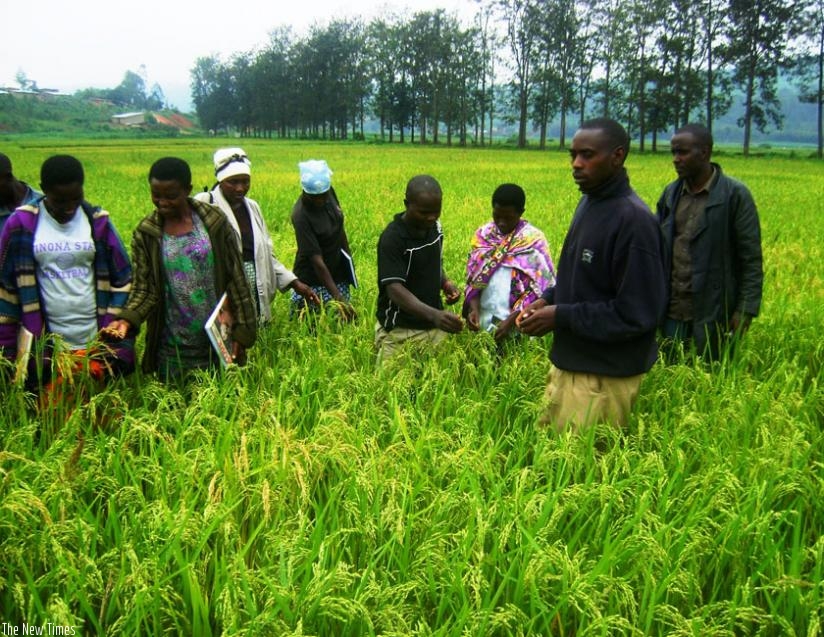Rwanda has been pushing for a shift from subsistence farming practices toward modern farming as one of the strategies to ensure sustainable food production, as well as improve farmers’ livelihoods through increased income from agro-activities. This is important since over 72 per cent of the population depends on the sector for a living.


Rwanda has been pushing for a shift from subsistence farming practices toward modern farming as one of the strategies to ensure sustainable food production, as well as improve farmers’ livelihoods through increased income from agro-activities. This is important since over 72 per cent of the population depends on the sector for a living.
With the many challenges the sector faced, including skeletal extension staff at Rwanda Agriculture Board (RAB), lack of access to inputs and poor farmer skills, the agriculture ministry had to devise strategies to solve them.
One of such strategies is the farmer-to-farmer extension service model known by its Kinyarwanda name, twigire muhinzi, which was launched in 2014. Launched in September 2014, the twigire muhinzi initiative was an answer to farmer complaints over lack of technical support (agronomists) and demonstration plots for farmers to learn new farming methods, a situation that had affected the sector’s productivity.
The initiative has eased access to extension support to rural farmers, which is provided by selected model farmers within the community called field facilitators. These facilitators also train their colleagues in modern agriculture practices to help improve production, as well as encourage farmers to look at agriculture as a business, according to RAB. They are trained by RAB before they assume their roles.
Louis Butare, the director general of the Rwanda Agriculture Board, said the initiative is yet to be fully implemented, but affirms that it has so far helped enhance farmers’ output, adding that many people have now embraced farming as a business.
"It’s been over a year since we introduced this agriculture extension model, but many farmers have appreciated and embraced it, and it is changing the way they look at agriculture now.”
Peasant farmers in the model districts of Gakenke and Kayonza have, for instance, recorded significant growth in crop production, according to Butare.
According to Telesphore Ndabamenye, the head of crops and food security at RAB, they are currently working with five districts - Gasabo, Ngoma, Gicumbi, Nyaruguru and Rubavu, apart from the model districts. "Since we still have a challengeof giving them are incentives, we wanted to work with those districts for capacity building and easily follow up to see the performance. We hope to roll it out to other areas after two seasons,” he noted. Farmers speak out
Jean Baptiste Bakinahe, a farmer from Runda sector in Kamonyi District, says farmers have been able to increase output. Bakinahe, a model farmer and field facilitator in his area under the twigire muhinzi scheme, says a farmer who used to harvest a bunch of bananas weighing 30 kilogrammes, now produces bananas that weigh between 100 and 120kg each, thanks to the programme.
"A farmer who used to harvest 5kg of cassava now produces 25 to 30kg from the same piece of because they use better farming methods and apply fertilisers. Cattle keepers have also been able to improve production with good feeding methods and animal care,” he notes.
Bakinahe says field facilitators like him assist farmers to embrace recommended crop and animal management practices, arguing that this is essential to help increase crop output.
He says the new extension approach that involves farmers supporting and training fellow farmers has encouraged more people to embrace modern agriculture, and better agronomical practices, which has boosted productivity and farmers incomes. It has eased access to extension services as we live within the communities where we serve compared to previously when we had to wait for RAB agronomists.
Theophile Tubanambazi, a model farmer in Gakoni cell, Muganza sector in Rusizi District, says under the new approach, farmers can readily get help at the village level, adding that it has also greatly improved access to inputs and hence the sector’s productivity.
"Farmers at the grassroots can now access basic extension services within their communities, provided by peers, thanks to the twigire muhinzi programme. We are now able to identify good seeds, and use recommended agricultural practices,” he says. He says previously, it was hard for farmers to get extension services, which affected output.
Tubanambazi says this has since changed, noting that farmers are now being trained on how to identify and control crop pests and diseases, as well as plant spacing, proper application of manure and artificial fertilisers, crop husbandry practices, and post-harvest handling.
"Besides production skills, farmers have acquired post-harvest and marketing skills.”
Clarisse Munezero, an agronomist in Gisagara District, notes that the model has reduced pressure on agronomists, who have sometimes been given other duties that affect their performance. Adding that there’s a change they’ve realised despite being newly established.
"In our district, we started implementing it during season A of 2015. Though it has not yet been fully established, there is a noticeable change.”
Munezero says facilitators in the district help farmers in their respective villages, where training for groups of 15-20 people is conducted.
"People can now select good seeds for planting, and how to selectively apply fertilizers, while many can stock their harvest and wait for better prices. This was never the case before,” she explained.
Challenges
Despite these achievements thus far, farmers still face a number of challenges. Tubanambazi says lack of market is still a big problem, especially during harvesting period.
"Crop production has increased, but there are no ready markets where we can sell our produce. Unstable prices also present a big challenge,” he says.
Because of these problems, some farmers cannot afford inputs, like fertilisers. He notes that extension workers and field facilitators are still few to cover all the farmers in any given areas.
Understanding the new extension service initiative
The twigire muhinzi extension model brings together two agricultural extension approaches – the farmer promoters, where the agriculture extension directorate trains selected farmers in communities, who then provide technical support to farmers in their localities in the absence of agronomists through the farmer-to-farmer extension system.
Under the programme that is co-ordinated by the local government, selected farmer promoters were trained in each of the 14,000 villages in Rwanda. The twigire muhinzi scheme also brought on board the earlier initiative, the farmer field school (FFS) model, which uses a participatory extension approach to train farmers on the holistic management of specific crops, according to RAB officials. In an FFS, farmers form FFS groups and "learn by doing” as they conduct season-long experimental trials on a single type of crop, they add.
"The FFS groups learn to addresses various crop-specific constraints with locally-appropriate specific solutions.”
The initiative is expected to help solve about 80 per cent of the challenges faced by grassroots farmers, promote commercial farming, and spur agro-production in the medium to long-term.
The government’s vision is articulated in various national strategy papers, including Vision 2020, the second Economic Development and Poverty Reduction Strategy (EDPRS II), and the third Strategic Plan for Transformation of Rwandan Agriculture (PSTA III). The overall goal of all the projects is changing the agriculture sector from a subsistence-based industry to a knowledge-intensive, market-oriented, and private sector-led industry.
business@newtimes.co.rw


